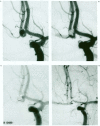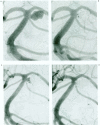Retreatment of cerebral aneurysms after guglielmi detachable coil embolization
- PMID: 20587295
- PMCID: PMC3490167
- DOI: 10.1177/15910199040100S129
Retreatment of cerebral aneurysms after guglielmi detachable coil embolization
Abstract
Of 175 patients with 181 aneurysms initially treated with Guglielmi Detachable Coils (GDC), 25 were retreated. All retreatments except one were performed on previously ruptured aneurysms. Thirteen aneurysms were retreated because of recurrence, and 12 aneurysms were retreated to complete initial insufficient embolization. Sixteen patients underwent re-embolization and 9 patients were operated upon surgically. No complications related to the retreatment were experienced. We consider that repeat embolization should be attempted before considering surgical treatment in case that additional therapy is required. However, it is difficult to retreat aneurysms having wide necks. In regard to surgical clipping, aneurysms without a coil in the neck are easier to treat with primary clipping, whereas aneurysms with a coil mass in the neck are difficult to surgical clip. We have never used temporary clipping and coil extraction if the distance between the coil and the parent artery was wider than 2 mm. Emerging new embolic agents or devices and technical improvement might decrease the need for retreatment and increase long-term efficacy after endovascular treatment.
Figures


Similar articles
-
Intra-aneurysmal Embolization for the Treatment of Cerebral Aneurysms Using Detachable Coils.Interv Neuroradiol. 1998 Nov 30;4 Suppl 1:67-9. doi: 10.1177/15910199980040S112. Epub 2001 May 15. Interv Neuroradiol. 1998. PMID: 20673445
-
Aneurysm clipping after partial endovascular embolization for ruptured cerebral aneurysms.Interv Neuroradiol. 2000 Nov 30;6 Suppl 1(Suppl 1):49-58. doi: 10.1177/15910199000060S105. Epub 2001 May 15. Interv Neuroradiol. 2000. PMID: 20667221 Free PMC article.
-
Stent-assisted embolization of internal carotid artery aneurysms.J Chin Med Assoc. 2003 Aug;66(8):460-6. J Chin Med Assoc. 2003. PMID: 14604309
-
Selection of cerebral aneurysms for treatment using Guglielmi detachable coils: the preliminary University of Illinois at Chicago experience.Neurosurgery. 1998 Dec;43(6):1281-95; discussion 1296-7. doi: 10.1097/00006123-199812000-00011. Neurosurgery. 1998. PMID: 9848841 Review.
-
Aneurysm retreatment after Guglielmi detachable coil and nondetachable coil embolization: report of nine cases and review of the literature.Neurosurgery. 1999 Apr;44(4):712-9; discussion 719-20. doi: 10.1097/00006123-199904000-00013. Neurosurgery. 1999. PMID: 10201295 Review.
Cited by
-
Therapeutic benefit of bone marrow-derived endothelial progenitor cell transplantation after experimental aneurysm embolization with coil in rats.PLoS One. 2014 Feb 28;9(2):e90069. doi: 10.1371/journal.pone.0090069. eCollection 2014. PLoS One. 2014. PMID: 24587209 Free PMC article.
-
"Coil mainly" policy in management of intracranial ACoA aneurysms: single-centre experience with the systematic review of literature and meta-analysis.Neurosurg Rev. 2018 Jul;41(3):825-839. doi: 10.1007/s10143-017-0932-y. Epub 2017 Nov 28. Neurosurg Rev. 2018. PMID: 29181806
-
Applications and Roles of Coil Embolization and/or Clipping in the Treatment of Cerebral Aneurysm.Interv Neuroradiol. 2006 Jan 20;12(Suppl 1):77-85. doi: 10.1177/15910199060120S111. Epub 2006 Jun 15. Interv Neuroradiol. 2006. PMID: 20569607 Free PMC article.
References
-
- Viñuela F, Duckwiler G, et al. Guglielmi detachable coil embolization of acute intracranial aneurysm: perioperative anatomical and clinical outcome in 403 patients. J Neurosurg. 1997;86:475–482. - PubMed
-
- Raymond J, Roy D. Safety and efficacy of endovascular treatment of acutely ruptured aneurysms. Neurosurgery. 1997;41:1235–1245. - PubMed
-
- Byrne JV, Sohn MJ, et al. Five-year experience in using coil embolization for ruptured intracranial aneurysms: outcomes and incidence of late rebleeding. J Neurosurg. 1999;90:656–663. - PubMed
-
- Murayama Y, Nien YL, et al. Guglielmi detachable coil embolization of cerebral aneurysms: 11 years’ experience. J Neurosurg. 2003;98:959–966. - PubMed
-
- Molyneux A. International Subarachnoid Aneurysm Trial (ISAT) Collaborative Group: International Subarachnoid Aneurysm Trial (ISAT) of neurosurgical clipping versus endovascular coiling in 2143 patients with ruptured intracranial aneurysms: a randomised trial. Lancet. 2002;360:1267–1274. - PubMed
LinkOut - more resources
Full Text Sources

